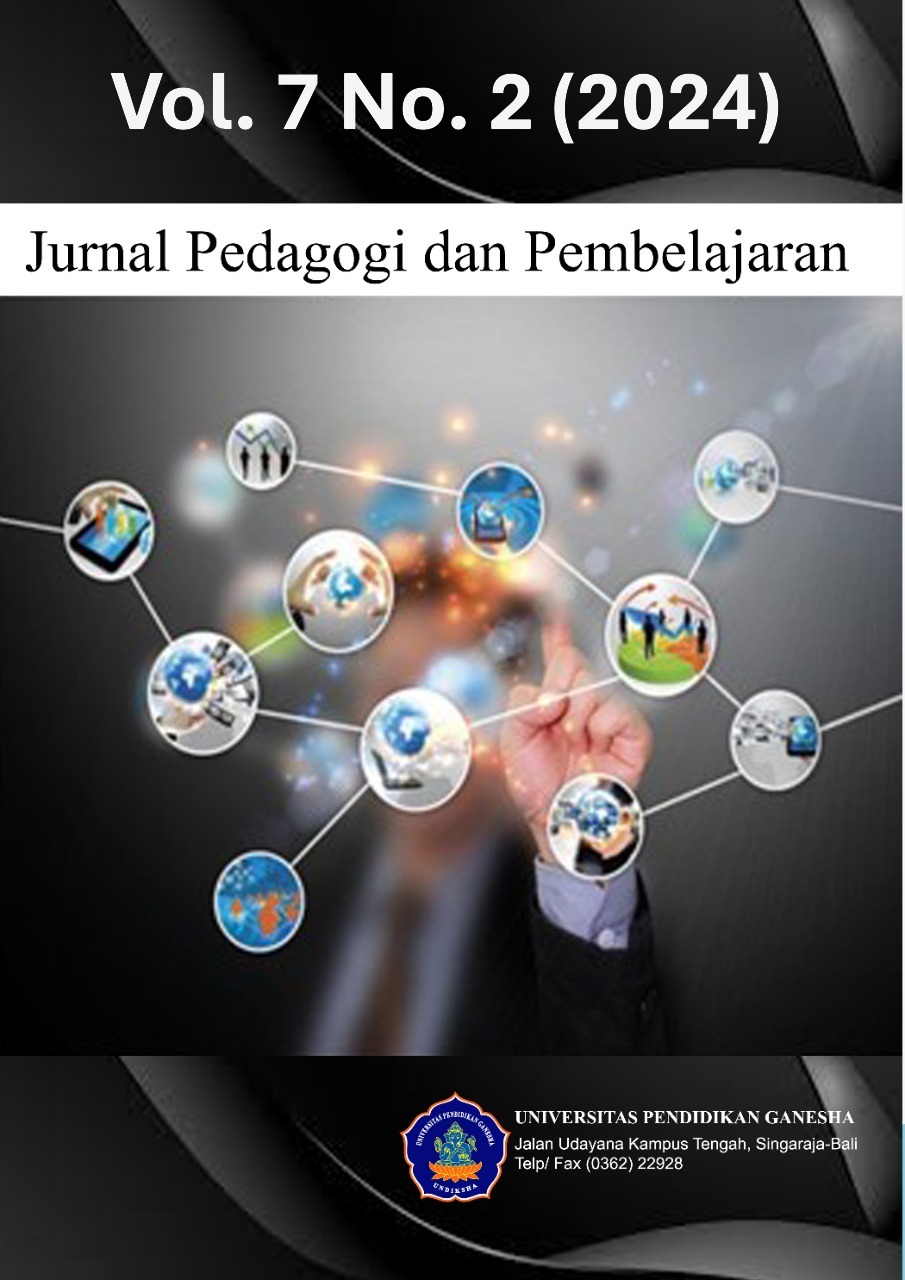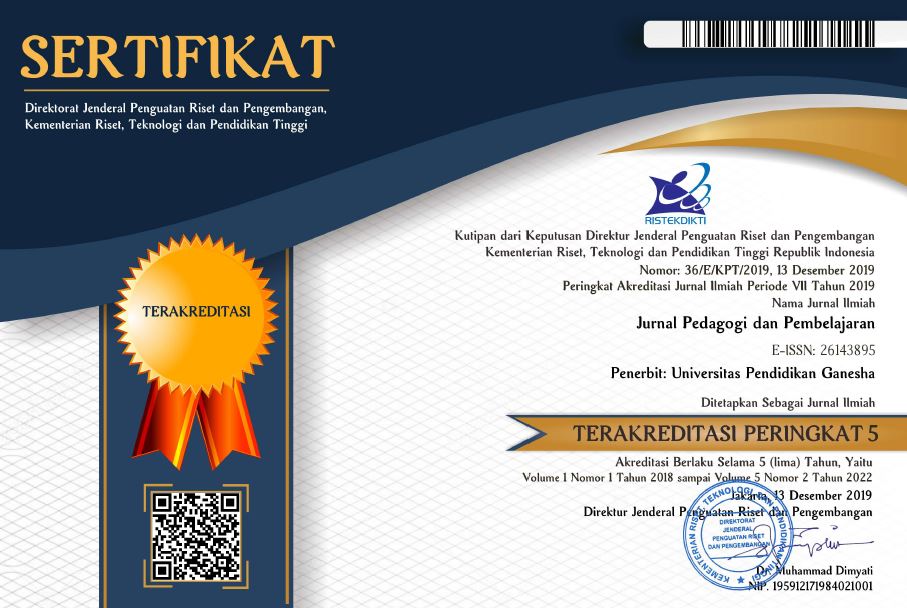STEM-Based Learning Module Oriented Towards Balinese Ethnomathematics to Enhance Students' Creative Mathematical Thinking Abilities
DOI:
https://doi.org/10.23887/jp2.v7i2.83930Keywords:
STEM-Based Learning, Balinese Ethnomathematics, Creative Mathematical Thinking AbilitiesAbstract
Currently there is a challenge in learning mathematics, namely creative thinking. Many students were found to have low mathematical creative thinking abilities. Therefore, this study aims to develop STEM-based learning module with a focus on Balinese ethnomathematics to improve students' creative mathematical thinking. This research used a plomp research design, this research involved 105 high school students who continued through the preliminary research, prototyping and assessment stages. Various instruments are used, including validation sheets, practicality assessments, and essay tests, using descriptive analysis. This research resulted in the creation of quality STEM-based learning modules, validated for their effectiveness and practicality. This module integrates elements of Balinese ethnomathematics, featuring instructional videos and interactive GeoGebra elements. This study identified learning trajectories involving three main activities related to middle school geometric transformations. The implementation of the module provides a significant increase in students' mathematical creative thinking abilities, as evidenced by the post-test results and the calculated n-gain value. In conclusion, the module developed is a valid, practical and effective tool for improving students' creative mathematical thinking, which combines STEM principles and Balinese ethnomathematics. The study emphasizes the importance of integrating cultural elements into educational materials to foster a deeper understanding of mathematical concepts. These findings underscore the potential of this approach to make a positive contribution to mathematics education, particularly in the context of local cultural relevance.
References
Arsić, Z., & Milovanović, B. (2016). Importance of computer technology in realization of cultural and educational tasks of preschool institutions. International Journal of Cognitive Research in Science, Engineering and Education, 4(1), 9–16. https://doi.org/10.5937/IJCRSEE1601009A. DOI: https://doi.org/10.5937/IJCRSEE1601009A
Castronovo, F., Stepanik, N., Van Meter, P. N., & Messner, J. I. (2022). Problem-solving processes in an educational construction simulation game. Advanced Engineering Informatics, 52(February), 101574. https://doi.org/10.1016/j.aei.2022.101574. DOI: https://doi.org/10.1016/j.aei.2022.101574
Chuseri, A., Anjarini, T., & Purwoko, R. Y. (2021). Pengembangan Modul Matematika Berbasis Realistik Terintegrasi Higher Order Thinking Skills (Hots) Pada Materi Bangun Ruang. Alifmatika: Jurnal Pendidikan Dan Pembelajaran Matematika, 3(1), 18–31. https://doi.org/10.35316/alifmatika.2021.v3i1.18-31. DOI: https://doi.org/10.35316/alifmatika.2021.v3i1.18-31
Cindy, E., & Silver, H. (2016). Problem-Based Learning: What and How Do Students Learn? Educational Psychology Review. Springer, 16(3), 235–266. https://doi.org/10.1023/B:EDPR.0000034022.16470.f3. DOI: https://doi.org/10.1023/B:EDPR.0000034022.16470.f3
Darmayanti, R., Baiduri, B., & Sugianto, R. (2022). Learning Application Derivative Algebraic Functions: Ethnomathematical Studies and Digital Creator Books. Jurnal Cendekia: Jurnal Pendidikan Matematika, 06(02), 2212–2227. https://doi.org/10.31004/cendekia.v6i2.1445.
Del Cerro Velázquez, F., & Méndez, G. M. (2021). Application in augmented reality for learning mathematical functions: A study for the development of spatial intelligence in secondary education students. Mathematics, 9(4), 1–19. https://doi.org/10.3390/math9040369. DOI: https://doi.org/10.3390/math9040369
Dhayanti, D., Johar, R., & Zubainur, C. M. (2018). Improving Students’ Critical and Creative Thinking Through Realistic Mathematics Education using Geometer’s Sketchpad. JRAMathEdu (Journal of Research and Advances in Mathematics Education), 3(1), 25. https://doi.org/10.23917/jramathedu.v3i1.5618. DOI: https://doi.org/10.23917/jramathedu.v3i1.5618
Dini, A., Rahmatan, H., Muhibbudin, N., C., & Safrida. (2023). Application of the E-module combined with the Guided Inquiry Learning Model to Increase Student Motivation and Learning Outcomes on the Structure and Function of Plant Tissues. Jurnal Penelitian Pendidikan IPA, 9(6), 4768–4776. https://doi.org/10.29303/jppipa.v9i6.3857. DOI: https://doi.org/10.29303/jppipa.v9i6.3857
Englund, C., Olofsson, A. D., & Price, L. (2017). Teaching with technology in higher education: understanding conceptual change and development in practice. Higher Education Research and Development, 36(1), 73–87. https://doi.org/10.1080/07294360.2016.1171300. DOI: https://doi.org/10.1080/07294360.2016.1171300
Fotiadou, A., Angelaki, C., & Mavroidis, I. (2017). Learner Autonomy as a Factor of the Learning Process in Distance Education. European Journal of Open, Distance and E-Learning, 20(1), 96–111. https://doi.org/10.1515/eurodl-2017-0006. DOI: https://doi.org/10.1515/eurodl-2017-0006
Fouze, A. Q., & Amit, M. (2023). The Importance of ethnomathematics education. Creative Education, 14, 729–740. https://doi.org/10.4236/ce.2023.144048. DOI: https://doi.org/10.4236/ce.2023.144048
Handayani, P., Restuti, M., Jannah, M., Ramadhani, K., Subali, E., & Isnaeni, W. (2019). Exploring the Local Potential of Banyumas Regency to Improve the Creative Thinking Ability of Elementary School Students. Profesi Pendidikan Dasar, 1(1), 69–80. https://doi.org/10.23917/ppd.v1i1.7269. DOI: https://doi.org/10.23917/ppd.v1i1.7269
Jamal, S. (2020). Analisis Kesiapan Pembelajaran E-Learning Saat Pandemi Covid-19 Di Smk Negeri 1 Tambelangan. Jurnal Nalar Pendidikan, 8(1), 16. https://doi.org/10.26858/jnp.v8i1.13561. DOI: https://doi.org/10.26858/jnp.v8i1.13561
Krelová, K. K., Berková, K., Krpálek, P., & Kubišová, A. (2021). Attitudes of Czech college students toward digital literacy and their technical aids in times of COVID-19. International Journal of Engineering Pedagogy, 11(44), 130–147. https://doi.org/10.3991/IJEP.V11I4.20821. DOI: https://doi.org/10.3991/ijep.v11i4.20821
Lampropoulos, G., Siakas, K., & Anastasiadis, T. (2019). Internet of Things in the Context of Industry 4.0: An Overview. International Journal of Entrepreneurial Knowledge, 7(1), 4–19. https://doi.org/10.2478/ijek-2019-0001. DOI: https://doi.org/10.2478/ijek-2019-0001
Maziyah, K. N., & Hidayati, F. H. (2022). Pengembangan E-Modul dengan Pendekatan STEM untuk Memfasilitasi Kemampuan Berpikir Kritis Siswa pada Materi Trignometri. Jurnal Tadris Matematika, 5(2), 241–256. https://doi.org/10.21274/jtm.2022.5.2.241-256. DOI: https://doi.org/10.21274/jtm.2022.5.2.241-256
McKown, C. (2019). Reliability, Factor Structure, and Measurement Invariance of a Web-Based Assessment of Children’s Social-Emotional Comprehension. Journal of Psychoeducational Assessment, 37(4), 435–449. https://doi.org/10.1177/0734282917749682. DOI: https://doi.org/10.1177/0734282917749682
Muskitta, M., & Djukri, D. (2016). Pengaruh model PBT terhadap kemampuan berpikir kritis dan kemampuan berpikir kreatif siswa SMAN 2 Magelang. Jurnal Inovasi Pendidikan IPA, 2(1), 58. https://doi.org/10.21831/jipi.v2i1.8809. DOI: https://doi.org/10.21831/jipi.v2i1.8809
Nurhikmayati, I., & Sunendar, A. (2020). Pengembangan Project Based Learning Berbasis Kearifan Lokal Berorientasi pada Kemampuan Berpikir Kreatif dan Kemandirian Belajar. Mosharafa: Jurnal Pendidikan Matematika, 9(1), 1–12. https://doi.org/10.31980/mosharafa.v9i1.604. DOI: https://doi.org/10.31980/mosharafa.v9i1.604
Octafianellis, D. F., Sudarmin, S., Wijayanti, N., & Pancawardhani, H. (2021). Analysis of student’s critical thinking skills and creativity after problem-based learning with STEM integration. Journal of Science Education Research Journal, 5(1), 31–37. https://doi.org/10.21831/jser.v5i1.41750.
Oschepkov, A. A., Kidinov, A. V., Babieva, N. S., Vrublevskiy, A. S., Egorova, E. V., & Zhdanov, S. P. (2022). STEM technology-based model helps create an educational environment for developing students’ technical and creative thinking. Eurasia Journal of Mathematics, Science and Technology Education, 18(5), 1–12. https://doi.org/10.29333/ejmste/12033. DOI: https://doi.org/10.29333/ejmste/12033
Palupi, R., & Septiana, A. R. (2018). An analysis on students ’ writing problems in academic writing class of English department STKIP PGRI Tulungagung in academic year 2017 / 2018. IALLTEACH (Issues In Applied Linguistics & Language Teaching), 2(1), 37–45. http://journal.uib.ac.id/index.php/iallteach/article/view/351.
Piotrowska, I., Cichoń, M., Sypniewski, J., & Abramowicz, D. (2022). Application of Inquiry-Based Science Education, Anticipatory Learning Strategy, and Project-Based Learning Strategies. In Didactic Strategies and Resources for Innovative Geography Teaching, 23–50. https://doi.org/10.4018/978-1-7998-9598-5.ch002. DOI: https://doi.org/10.4018/978-1-7998-9598-5.ch002
Pramesti, D., Probosari, R. M., & Indriyanti, N. Y. (2022). Effectiveness of Project Based Learning Low Carbon STEM and Discovery Learning to Improve Creative Thinking Skills. Journal of Innovation in Educational and Cultural Research, 3(3), 444–456. https://doi.org/10.46843/jiecr.v3i3.156. DOI: https://doi.org/10.46843/jiecr.v3i3.156
Priyatni, E. T., & Martutik. (2020). The Development of a Critical–Creative Reading Assessment Based on Problem Solving. SAGE Open. https://doi.org/10.1177/2158244020923350. DOI: https://doi.org/10.1177/2158244020923350
Pujiastuti, H., Suvati, D. A., Haryadi, R., & Marethi, I. (2020). Development of mathmodule based on local wisdom and 21stcentury skills: Linear equation system. Journal of Physics: Conference Series, 1480(1). https://doi.org/10.1088/1742-6596/1480/1/012052. DOI: https://doi.org/10.1088/1742-6596/1480/1/012052
Putri, K. E., Nurmilawati, M., & Zunaidah, F. N. (2023). Developing an Integrated Mathematics and Science Module with Merdeka Curriculum for Elementary School. AL-ISHLAH: Jurnal Pendidikan, 15(4). https://doi.org/10.35445/alishlah.v15i4.3681. DOI: https://doi.org/10.35445/alishlah.v15i4.3681
Ratama, I. P., Padmadewi, N. N., & Artini, L. P. (2021). Teaching the 21st Century Skills (4Cs) in English Literacy Activities. Journal of Education Research and Evaluation, 5(2), 223. https://doi.org/10.23887/jere.v5i2.30849. DOI: https://doi.org/10.23887/jere.v5i2.30849
Rohmitawati, R. (2018). The implementation of TPACK (yechnology, pedagogy, and content knowledge) framework on indonesian online mathematics teachers training. Southeast Asian Mathematics Education Journal, 8(1), 61–68. https://doi.org/10.46517/seamej.v8i1.64. DOI: https://doi.org/10.46517/seamej.v8i1.64
Saputra, B., & Sujarwanta, A. (2021). Tranformasi Pembelajaran Berbasis Proyek Science, Technology, Engineering and Mathematics di Masa Pandemi Covid-19. BIOLOVA, 2(1), 1–8. https://doi.org/10.24127/biolova.v2i1.491. DOI: https://doi.org/10.24127/biolova.v2i1.491
Septianto, W., & Hasan, M. K. U. (2017). Efektivitas Penggunaan Media Pembelajaran Elektronik Interaktif Pada Hasil Belajar Siswa. Jurnal Pendidikan Vokasional Teknik Mesin, 5(3), 175–181. https://doi.org/10.21831/teknik%20mesin.v5i3.7107.
Sirate, S. F. S. (2011). Studi Kualitatif Tentang Aktivitas Etnomatematika Dalam Kehidupan Masyarakat Tolaki. Lentera Pendidikan : Jurnal Ilmu Tarbiyah Dan Keguruan, 14(2), 123–136. https://doi.org/10.24252/lp.2011v14n2a1. DOI: https://doi.org/10.24252/lp.2011v14n2a1
Sulistyaningsih, Sulam, K., Syakur, A., & Musyarofah, L. (2019). The Implementation of 21st Century Skills as the New Learning Paradigm to the Result of Student’s Career and Life Skills. Magister Scientiae, 1(1), 1–10. https://doi.org/10.51836/journeel.v1i1.37. DOI: https://doi.org/10.51836/journeel.v1i1.37
Tentama, F., & Riskiyana, E. R. (2020). The role of social support and self-regulation on work readiness among students in vocational high school. International Journal of Evaluation and Research in Education, 9(4), 826–832. https://doi.org/10.11591/ijere.v9i4.20578. DOI: https://doi.org/10.11591/ijere.v9i4.20578
Tjeerd Plomp. (2013). Educational Design Research: an Introduction. In T. Plomp & N. Nieveen (Eds.), An Introduction to Educational Design Research (pp. 9–36). Netzodruk, Enschede. https://www.academia.edu/download/48472657.
Tytler, R., & Prain, V. (2022). Interdisciplinary mathematics and science - a guided inquiry approach to enhance student learning. Teaching Science, 68(1), 31–43. https://doi.org/10.3316/informit.362070229925660.
Ulandari, N., Putri, R., Ningsih, F., & Putra, A. (2019). Efektivitas Model Pembelajaran Inquiry terhadap Kemampuan Berpikir Kreatif Siswa pada Materi Teorema Pythagoras. Jurnal Cendekia : Jurnal Pendidikan Matematika, 3(2), 227–237. https://doi.org/10.31004/cendekia.v3i2.99. DOI: https://doi.org/10.31004/cendekia.v3i2.99
Winandari, A., Sutimin, L. A., & Rejekiningsih, T. (2022). Benefits of Using Experiential Learning Based Electronic Modules to Facilitate Students Concierge Learning in Vocational High Schools. Journal of Education and Technology, 6(4), 568–577. https://doi.org/10.23887/jet.v6i4.48064. DOI: https://doi.org/10.23887/jet.v6i4.48064
Winatha, K. R., & Abubakar, M. M. (2018). The Usage Effectivity of Project-Based Interactive E-Module in Improving Students’ Achievement. Jurnal Pendidikan Teknologi Dan Kejuruan, 24(2), 198–202. https://doi.org/10.21831/jptk.v24i2.20001. DOI: https://doi.org/10.21831/jptk.v24i2.20001
Yassir, M., Syam, H., & Nur, H. (2022). Higher Order Thinking Skills (HOTs) based Assessment for Learning: A Model for Computer Networks Learning in Vocational School. Asian Journal of Applied Sciences, 10(1). https://doi.org/10.24203/ajas.v10i1.6876. DOI: https://doi.org/10.24203/ajas.v10i1.6876
Downloads
Published
How to Cite
Issue
Section
License
Copyright (c) 2024 Kadek Dwiki Juliantara

This work is licensed under a Creative Commons Attribution-ShareAlike 4.0 International License.
Authors who publish with Jurnal Pedagogi dan Pembelajaran agree to the following terms:
- Authors retain copyright and grant the journal the right of first publication with the work simultaneously licensed under a Attribution-ShareAlike 4.0 International (CC BY-SA 4.0) that allows others to share the work with an acknowledgment of the work's authorship and initial publication in this journal
- Authors are able to enter into separate, additional contractual arrangements for the non-exclusive distribution of the journal's published version of the work (e.g., post it to an institutional repository or publish it in a book), with an acknowledgment of its initial publication in this journal.
- Authors are permitted and encouraged to post their work online (e.g., in institutional repositories or on their website) prior to and during the submission process, as it can lead to productive exchanges, as well as earlier and greater citation of published work. (See The Effect of Open Access)











